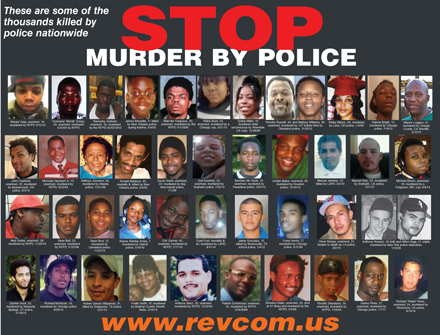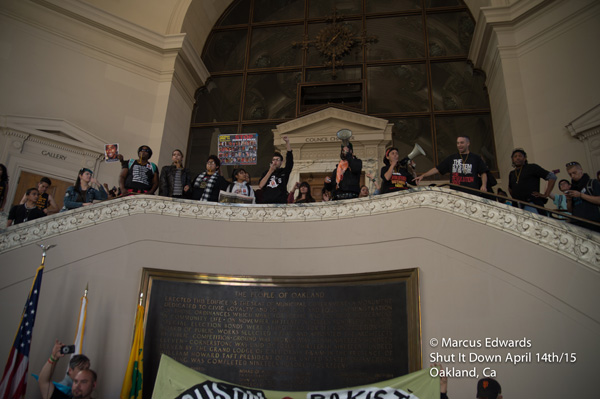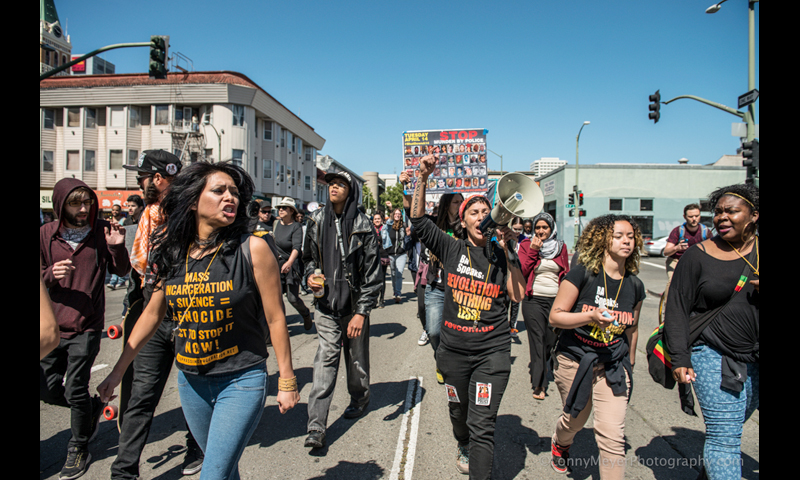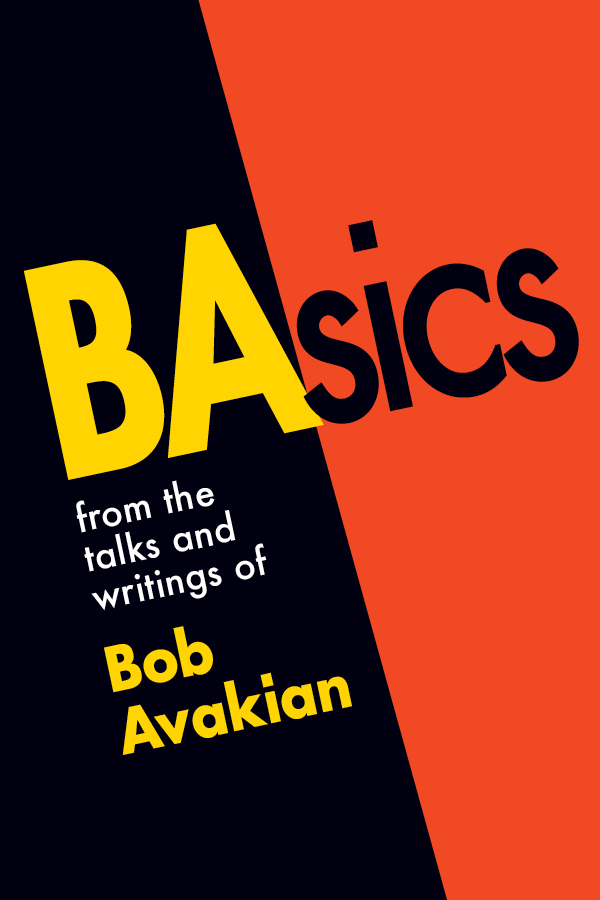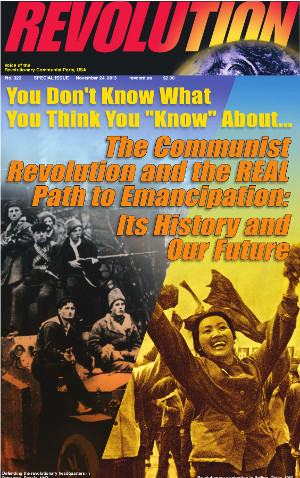Thoughts on April 14: The Day to Stop Murder by Police
June 1, 2015 | Revolution Newspaper | revcom.us
Demonstrations against police murder on April 14 marked a new beginning for the struggle against this outrage. This is crucially important, for without mass struggle there can be no progress whatsoever and the powers-that-be will just hammer people into the ground. Further these demonstrations had important potential significance for revolution—for finally getting free of a society in which murder by police continues to go on daily and more, and people continue to be oppressed more generally... a society in which the lives of Black and other oppressed people are treated as if they do not matter. A14 was a great day, a great beginning—and now the challenge is to learn the lessons and take it further. Following are some thoughts from a reader.
From a reader:
Clearly all the outrage that was unleashed last fall around the non-indictments of the murderers of Michael Brown and then Eric Garner, which tapped into decades of repressed rage about an epidemic of police violence, receded just below the surface in recent months, and then was pushed back up and out into the world on April 14, across the country. Just like it is unlikely that the murder of Eric Garner would have received such attention if the people in Ferguson, Missouri, some of the most targeted people in the country, did not stand up and fight back in such a determined way and with such moral certitude, it’s difficult to say if the murders of Walter Scott and Freddie Gray would have triggered mass outpourings if it weren’t for a new climate where so many people are refusing the rationalizing and misdirection coming from the top.
I think #ShutDownA14 got bigger than a lot of people working on it expected, if what we were using to gauge the potential was just what we were hearing from the people we were talking to. It wasn’t clear how many people would participate, and there were a lot of times where we tried to involve people on the level of organizing and taking responsibility that did not work out like we had hoped. Most of us in the Revolution Club locally were having trouble, in the days leading up to A14, seeing how it could have a huge impact on society, from where we were standing and from what we understood about what was happening in other places, too.
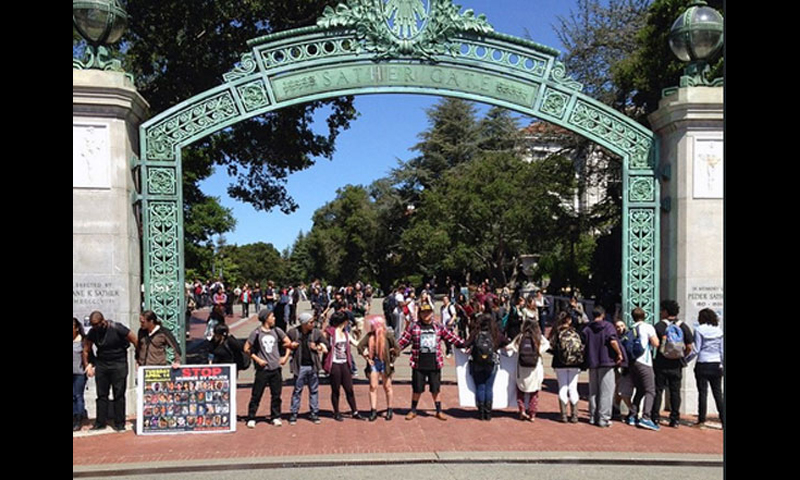
UC students at Berkeley blocking Sather Gate, the main entrance to campus. Photo: Melanie Jaycee_Instagram
For one thing, this was another lesson in understanding what it means to be working on a social fault line. A hundred Cal students blocking Sather Gate, and thousands shutting down the Brooklyn Bridge, can seem like it came out of nowhere, when it came very concretely out of all the years of oppression, the recent change in mood around what people should learn to accept versus fight like hell, and the work of revolutionaries who understand the potential of all this and find the epidemic of police brutality unacceptable and unnecessary.
One thing that was said by a Black man in his 30s at a Revolution Club meeting after A14, was, “I’ve been waiting since November for this to happen.” I heard similar sentiments from high schoolers, many of whom did not participate in the protests last fall and winter, but wanted to now. Some of them were frustrated that it seemed like all the fighting stopped; whether they had been part of it or not, they wanted to see it continue. This was also true on college campuses, and part of both the challenge and the possibility of re-seizing the initiative at this moment.
The battle for summation of those protests sparked by Ferguson last summer was a key part of this whole last period. What was said just before A14, about the polarization between those who support the police and those who stand with the oppressed, and the polarization, among those who want to see police brutality ended, between outrage and conciliation, manifested repeatedly in the time leading up to this day through a conflicted view of what happened last year—what was the main character of those protests, what potential do they reveal, what difference did it make, why did the relentlessness of it all recede, and why it matters that this fight not subside in this moment but go to a whole other level. Just like a lot of people who wanted to see this make a comeback and go further, a lot of those same people thought the protesting either did not have the desired effect (concrete “justice” rulings), or just gave up or lacked the determination to continue, or thought that the movement was torn apart from the inside -- people just could not unite or some “violent” people ruined it for everyone else. This represented a contradiction between people’s higher aspirations for ending police brutality and a willingness to go along with it, accepting the stories told by the ruling class and reactionaries about what is desirable / possible / necessary. The same people were beginning to see the illegitimacy of the police and the system they enforce.
Throughout the whole time building for A14, it was a huge struggle to get people to apply what they had learned last year to a new situation that in most ways is even more favorable for people to join this fight and take it higher. Students saw, many for the first time, the repressive and violent way the police come down on people who are fighting back, which both pushed the urgency of why we need resistance and revolution and struck a blow to the cops' perceived legitimacy, but also had a chilling effect where students in particular had a sobering view of what they are risking by doing the right thing -- injury, death, felony charges, prison time, etc.
Method and morality were important elements in the whole process. A lot of this was concentrated by the approach taken with the Stolen Lives poster. This was a way to make good on meeting the need to go much more broadly and involve people of conscience on different levels (including the social media campaign and the hashtag, which went crazy within 24 hours of A14).
The approach was to confront people with reality, set terms based on what is actually happening with the police killing people with impunity, and urge their participation in changing history, on the basis that this is morally reprehensible and what people do can make a difference. There was a level on which this was low-risk, and there was a level on which it was actually a pretty strong statement, and when considering people’s relationship to their social media, definitely not without risk. They are taking sides in public, in front of their friends, prospective employers, colleagues and classmates, etc.
It is really important to get people to where they are deciding what they do is based on the need and the possibility, instead of some other reason. After the students at one college left our first meeting, they did try to talk about walking out to some of the people they knew, and were mainly asked who was behind the action and using that as their criteria for whether they should act. One student organizer was asked several times, is revcom.us involved? To which she replied that she didn’t know. One of the people she talked to said, “I’m so sick of those people. I was out with my Black queer friend and they actually told her she needed to act on April 14,” and on and on about what gives them the right, don’t they think she already knows, blah, blah, blah. The students who were trying to push for A14 exchanged glances, discussed it later with each other, working out how wrong that attitude is, but did not challenge this person on the spot. My impression is that this kind of thing happened quite a bit and took the wind out of their sails in a way. What they did not condemn at any point was the idea that direct experience / identity provides a kind of authority that is unquestionable, even when a person is using it to justify doing nothing in the face of a genocide. Because that is something they don’t fully disagree with, and neither of them is Black, so it paralyzes them in a way.
This particular approach obviously does not always take training, and it’s different for different people, how naturally it can come. When some students did walk out, there was one professor (Black and female) who canceled all her classes for the day and joined them on the lawn. Out there, they were mainly making signs for the protest, but not drawing any attention to themselves, except this professor. She went to students walking by, saying, “Why aren’t you here? You don’t have class, I canceled it.” And at least one student response was, “I just saw mainly white people, so I didn’t bother,” to which this professor came back, “Really? That should mean you come over twice as fast.” Ha! This was her own way of challenging her students around their criteria for what they are going to participate in, based on what’s actually needed or something else.
I think going out there with these students trying to do this kind of thing is key, so they can see the approach modeled. It helps to have a form like the centerfold, but being able to wield it in a way that is not defensive is something that can take some training and modeling, maybe especially in the case of raging identity politics that most students do not know how to combat. In retrospect, while I had thought that these students declined my on-the-ground support out of confidence, now I can see that they knew that if I was there it would have stirred some shit up in a way they really didn’t want to. They saw it like everyone at school agrees with the need to end police brutality, and while we did talk about why this would be hard and the struggle and challenge the situation calls for, I’m sure that they thought there was an easier way.
This is not exactly the same but related to the response from college students and others at a showing of the clips from the Dialogue before the film premiered, which was also part of building for A14 and learning what people were thinking, and battling for summation of the fall and assessing what is needed now. There was an overwhelming unity with Cornel West’s diagnosis of a culture that hardens people’s hearts as robbing people of the “raw material that movements are made of.” This unity, however, was contextualized by a hope that there was some other way to bring about the changes that are needed other than to throw everything into disarray through determined protest, people in the streets, shutting things down, the repression that follows, the ways in which the media can mischaracterize what the movement is doing, etc.
This is a question of “isn’t there some other way?” that will continue to emerge that we can answer, because there is a system, and a ruling class, and a whole history of resistance and revolution, that there is not a way to rely on the avenues and instruments of a state that is driven to commit crimes against humanity to put an end to those crimes. Similarly, we are not going to change people’s minds from relying on the system to doing what needs to be done without stepping on some proverbial toes. Is there any other way? Well, no, because the dominant narrative has been constructed by the ruling class, that the police and the system are legitimate and that this whole horror is something we need to either accept or go through their official channels to change. So no, there are no shortcuts around re-polarization or mass resistance.
The participation of high schoolers in the protests in this area was a huge source of inspiration to people of all ages, and the most surprising if we were expecting the turnout to directly affect “our work” versus a larger potential based on the fault line itself. Over a dozen different high schools were represented in Oakland, and bigger groups of kids from a smaller number of schools in SF (I think). Many teenagers spoke at the rally and inside City Hall in Oakland, and it was clear that they took this seriously, and some of them were doing it in the face of real consequences from their parents or their schools.
I talked to a group of six students from one high school before the rally began who were so excited to be there. One of them told me, “We have been in this super-strict school system for six years, and there are so many rules. They are all about the rules. And we have been following the rules our whole lives. Today was the first time we ever broke the rules, we walked out, because this is too important.” Minutes later their principal showed up to demand that they go back to school or be suspended. One of them told the principal, “You don’t know what it’s like to be us” and made a whole argument about how the principal is ignoring the fact that these students have to live in fear of being killed or having loved ones killed by the police. The march soon took a detour to go to that school, pound on the walls and chant and sticker, to support those students and have their backs for taking that risk and doing the right things.
I talked with two groups totaling fifty 10th grade students in San Francisco (each about 1/3 Black, Latino, and white) the day before and the day of A14 and showed them the video of the murder of Walter Scott, a mock report from NBC called “What if there had been no video?” which showed in a disturbing way how so many news reports on police murder are just regurgitated lies from police reports which blame the victim and show the cops as having “done all they could” when nothing could be further from the truth; a clip from Cal Berkeley speak-out with Laurie Valdez talking about what her family has been through since the police murder of her husband, and finally the video call to action for A14. These kids, many of whom had been critical of the protests last fall, were ecstatic to hear that this wasn’t over, and overwhelmingly were enraged by the Walter Scott story, sort of mind blown by seeing that mock report and realizing how often this happens and how it is shaping public opinion while the cops get a way with murder, and were moved to tears by Laurie’s story. One student is a teenager whose cousin was murdered by police and added facts from his experience on how excessive the violence is, and how dishonest police are at every stage in the process, supporting what Laurie was saying. Another student vocalized what I’m sure a lot of students were thinking, where after every video and discussion of it, she was voicing such contempt for the police, at the same time she was weighing what the consequences would be from the school and her mom if she went to the demonstration. The conflict became more and more unbalanced in the direction of this is so fucked up, nothing is more important than fighting this shit. Then finally when the call to action video ended with the video of Eric Garner, with the unnervingly loud reading of his last words, she said, “Fuck it. Fuck this. I’m going. This has to stop.” She and about 100 others from all grades walked out 20 minutes later. Many of them went to the demo in SF, spoke out, occupied city hall, chalked up the police station, and so on. Some of the 12th graders from this same school went straight to another high school and fliered there to bring others. They were kicked out by the principal and returned anyway, made a big scene, and drew a small number of students from that school into the protest.
One thing that really stood out to this group after participating were how many young people were there. There was a kid they thought must have been 10 years old, getting up in the face of the cops, pointing to himself, saying, “This is what a victim of police brutality look like! I’m a Latino kid! I have no gun! Do you want to kill me now?” They were very moved by his courageous and defiant truth-telling. Another thing that stood out was a story a woman told about being raped by a cop. There was a lot of shock for them involved in hearing that. It was another level of realizing the illegitimacy of the police. Also it was an opportunity to talk about the system that is deeper than racism. We talked also about the rate of police violence against the mentally ill, how this system sees some people as totally useless, property or a threat, and one part of that being white supremacy, but that is not confined to race and includes patriarchy and seeing people who are not profitable as expendable. This was an important thing for them that I totally had not addressed directly with them in this whole process other than in the abstract, but hearing that woman’s story at the protest made them question things and opened up the conversation and the outrage on a whole other level. They were also very inspired to hear and see all the kids on the Brooklyn Bridge and feel part of something much bigger than what they did locally, which they were feeling pretty damn good about anyway. Questions of “What’s the next thing?” were also common in this group.
There was a group of Latino middle school students who came out and did not go to school that day because they were sure that the school would send a van to round them up and return them. One of these students had a mom who was very supportive, and when the school called her in a kind of a panic, she said, “Thanks for letting me know” and hung up while the school was trying to find out more about where he could be! This kid was sure that the school used their wi fi network to find out which students were involved in the protests or in conversation with the students who were absent that day, though it’s unclear how and if that’s what happened. Heavy if it did happen, and heavy that he was sure that they would do that if they could. He also said he returned to school a hero. He had been frustrated with his friends who didn’t seem to think going to protest that day was worth the risk, and the next day at school all his friends could say was that they saw him on the news, what a badass he was, and when is this happening again? Can we come next time? Not only did his school not say anything to him about the absence, but he also learned that one of his teachers was especially supportive, proud of him, and could possibly support this whole movement in a number of ways if presented with the possibility.
In the meeting where we heard these stories, in San Francisco, which drew about 20 people, there was also a cry for “What’s next?” One young Latino man who came said he watched his dad get shot by the cops in their car in Florida when he was 12 years old. The cop was convicted but he was not satisfied with that. He said, “It doesn’t bring my dad back. And they keep doing it to more people.” He thought there was something specific about police in Florida, but having moved to California just a few months ago, was shocked and dismayed to see that this even happens in California. A woman who came to this meeting is the girlfriend of an immigrant man who was just shot by the cops a month or so ago, and she among others at that meeting were already referring to themselves as members of the Revolution Club, and wanting to know and work on “what’s next.”
At another post-A14 meeting, instead of focusing on what happened and what’s next, the people who came mainly wanted to talk about what was the way out, and it was a whole conversation about revolution versus reform. It was similar in the sense of two newer people expressing “I’m with you now” in relationship to the Revolution Club. The conversation was complicated and very interesting.
In the course of this, it seems like we ran into every kind of argument for conciliation, along with so much evidence that so many people are in fact thinking differently since the fall about the police and what they represent. It was kind of maddening at times, to be honest! That all these people had their minds changed last fall but were arguing against the effectiveness of doing the thing that obviously was very effective when it came to shifting the way they themselves and society at large sees who are the good guys and who are the bad guys, which is such a key part of re-polarizing, resisting, weakening the rulers, and strengthening the revolution.
At the same time, it is unavoidable that this was a big “first time” protest that was defiant and had a real impact. So many kids glowing with pride, taking risks, voicing outrage, drawing pigs in chalk on the police station, jumping up on the desks in multiple city halls, truly interrupting routine and taking personal risks and feeling strengthened by their peers around them that were acting in righteous and determined ways that they had trouble imagining the day before. It was also hugely inspiring to at least thousands of people, as evidenced by individual responses, media coverage, and social media response. This was a big deal for teenagers across the country, and maybe even internationally.
There were also some important connections that were made, building on what happened in the fall, between struggles against state violence in different countries. The surviving students from the Ayotzinapa massacre in Mexico supported actions at UC Berkeley and made powerful statements that the police acting this way with impunity has to be stopped everywhere, and that it’s inspiring to see people in the U.S. fighting against how that manifests here. A journalist who spoke at UC Berkeley gave total support to A14. She said in her talk, the more people see that the answers will not come from the people on top, the better. She said it is not just a question of solidarity among struggles, it is the same struggle (referring to what is happening in Palestine and what is happening here, the struggles against state repression in a system for profit). In Oakland, someone brought a huge banner that said, “FROM FERGUSON TO PALESTINE, BLACK AND ARAB LIVES MATTER.” All this is pretty great, and goes up against all the identity politics and divisive shit that can be poison for a movement like this one.
What’s next?
I wonder why this went down the way that it did, in relationship with what to do next to build this fight, push at this crack, and build the movement for revolution, too. I wonder how much the blatant murder and the released video of Walter Scott had to do with who came out that day. I wonder how much impact the campus work had and how much impact the social media campaign had, as well as why the social media stuff rocketed off the charts just one day before the protests. Obviously Ferguson and everything that happened last year had a lot to do with even the response to Walter Scott, and what was accomplished on A14 too.
The main point is that what is needed hasn’t changed, and the potential for it hasn’t changed, even if it does not look on the surface like a lot of people are throwing into this right now (which was true). However, something did actually happen “between now and then” which was this video of Walter Scott. It made me wonder how much of what happened had much at all to do with what we were doing on the campuses up until then.
I am thoroughly convinced that the kind of speak-outs that happened in NYC and Berkeley with the family members of the victims of police brutality, student activists, and revolutionaries, is a very important thing to keep doing and pushing and bringing people into and publishing and sharing and spreading and getting different people to participate in, support, and relate to. It was very much like the “People’s Hearings” that put the anti-abortion movement and the system on trial through the stories of the people most affected by that oppression. Just in the same way that those hearings drew a line in the sand, so did those speak-outs— in the same spirit of the Stolen Lives centerfolds: Here is reality. What side are you on? Although I still don’t know if very many people at all saw those events, and I wonder how we could maybe get some of them to people with influence or enormous social media followings because it is like a rallying cry, it makes some things unavoidable, it unmasks the horrors, it models determined resistance and a refusal to accept these atrocities, it rips the legitimacy off of this system, and it puts the onus on all of us to fight to stop this. I know these stories reached further than the attendance, by being shown in classrooms, and also being wielded by people working on pulling other people into this. Members of the Revolution Club, as well as students at Sather Gate, were telling these stories in argument as to why we need to stop business as usual, and why more people should throw into putting an end to police murder. These are so powerful I just really want to find the ways to keep doing them, and to get to the kinds of people who can help make them really widespread.
I’m also not sure exactly what was the impact of the Dialogue that Cornel West and Bob Avakian had during this time, though I know to whatever extent it was used in conjunction with a call to action for A14 it was effective. There were also things about the premiere of the film that showed how much these questions are on people’s minds or they want them to be. The fact that the ticket website sent a mass email about a bunch of different things and about a dozen people showed up in Berkeley at that premiere just based on that generic announcement from the ticket company -- the kind of email a lot of people don’t even read -- says something. And the conversation that was opened up about what way forward for the struggle against police brutality that was a result of people watching those clips is undeniable -- it has the potential to raise the level of the conversation and open up much-needed debate over what humanity needs.
What I am sure of is that more is possible than before, like we stuck a jam in the door that was opened last year through all that resistance. I think it’s important that defiant action continue, along with organizing and fundraising. We should not wait long before provoking and leading many other kinds of actions, bringing leaders out of this, in this spirit of shutting things down and demanding and END to police murder, and forcing society to confront the reality and gravity of the situation, as well as inspire people to act on the basis that the moment is urgent, and they can be part of changing everything.
Volunteers Needed... for revcom.us and Revolution
If you like this article, subscribe, donate to and sustain Revolution newspaper.

